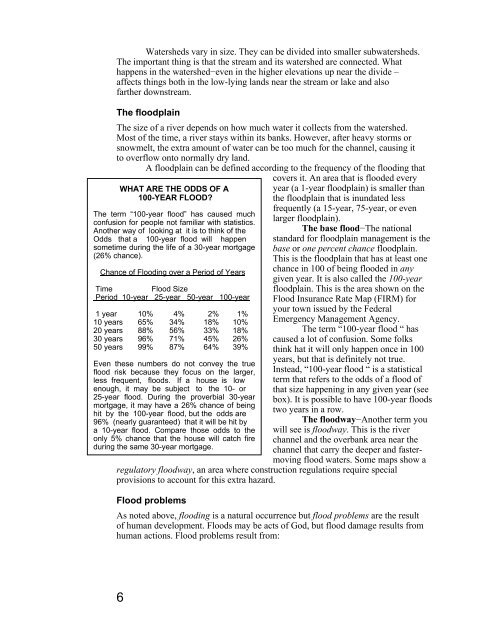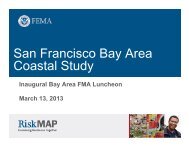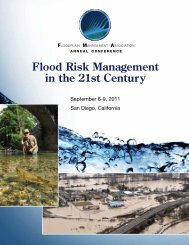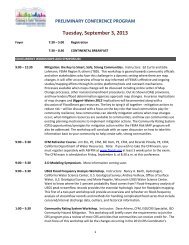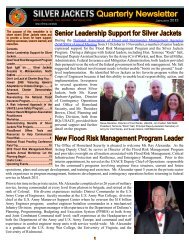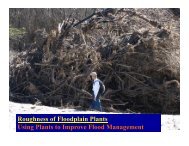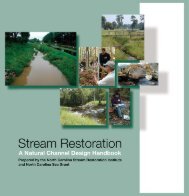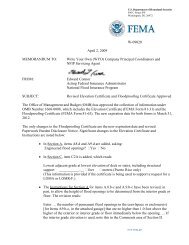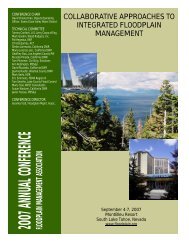Using Multi-Objective Management to Reduce Flood Losses in Your
Using Multi-Objective Management to Reduce Flood Losses in Your
Using Multi-Objective Management to Reduce Flood Losses in Your
You also want an ePaper? Increase the reach of your titles
YUMPU automatically turns print PDFs into web optimized ePapers that Google loves.
Watersheds vary <strong>in</strong> size. They can be divided <strong>in</strong><strong>to</strong> smaller subwatersheds.<br />
The important th<strong>in</strong>g is that the stream and its watershed are connected. What<br />
happens <strong>in</strong> the watershed−even <strong>in</strong> the higher elevations up near the divide –<br />
affects th<strong>in</strong>gs both <strong>in</strong> the low-ly<strong>in</strong>g lands near the stream or lake and also<br />
farther downstream.<br />
The floodpla<strong>in</strong><br />
The size of a river depends on how much water it collects from the watershed.<br />
Most of the time, a river stays with<strong>in</strong> its banks. However, after heavy s<strong>to</strong>rms or<br />
snowmelt, the extra amount of water can be <strong>to</strong>o much for the channel, caus<strong>in</strong>g it<br />
<strong>to</strong> overflow on<strong>to</strong> normally dry land.<br />
A floodpla<strong>in</strong> can be def<strong>in</strong>ed accord<strong>in</strong>g <strong>to</strong> the frequency of the flood<strong>in</strong>g that<br />
WHAT ARE THE ODDS OF A<br />
100-YEAR FLOOD<br />
The term “100-year flood” has caused much<br />
confusion for people not familiar with statistics.<br />
Another way of look<strong>in</strong>g at it is <strong>to</strong> th<strong>in</strong>k of the<br />
Odds that a 100-year flood will happen<br />
sometime dur<strong>in</strong>g the life of a 30-year mortgage<br />
(26% chance).<br />
Chance of <strong>Flood</strong><strong>in</strong>g over a Period of Years<br />
Time<br />
<strong>Flood</strong> Size<br />
Period 10-year 25-year 50-year 100-year<br />
1 year 10% 4% 2% 1%<br />
10 years 65% 34% 18% 10%<br />
20 years 88% 56% 33% 18%<br />
30 years 96% 71% 45% 26%<br />
50 years 99% 87% 64% 39%<br />
Even these numbers do not convey the true<br />
flood risk because they focus on the larger,<br />
less frequent, floods. If a house is low<br />
enough, it may be subject <strong>to</strong> the 10- or<br />
25-year flood. Dur<strong>in</strong>g the proverbial 30-year<br />
mortgage, it may have a 26% chance of be<strong>in</strong>g<br />
hit by the 100-year flood, but the odds are<br />
96% (nearly guaranteed) that it will be hit by<br />
a 10-year flood. Compare those odds <strong>to</strong> the<br />
only 5% chance that the house will catch fire<br />
dur<strong>in</strong>g the same 30-year mortgage.<br />
covers it. An area that is flooded every<br />
year (a 1-year floodpla<strong>in</strong>) is smaller than<br />
the floodpla<strong>in</strong> that is <strong>in</strong>undated less<br />
frequently (a 15-year, 75-year, or even<br />
larger floodpla<strong>in</strong>).<br />
The base flood−The national<br />
standard for floodpla<strong>in</strong> management is the<br />
base or one percent chance floodpla<strong>in</strong>.<br />
This is the floodpla<strong>in</strong> that has at least one<br />
chance <strong>in</strong> 100 of be<strong>in</strong>g flooded <strong>in</strong> any<br />
given year. It is also called the 100-year<br />
floodpla<strong>in</strong>. This is the area shown on the<br />
<strong>Flood</strong> Insurance Rate Map (FIRM) for<br />
your <strong>to</strong>wn issued by the Federal<br />
Emergency <strong>Management</strong> Agency.<br />
The term “100-year flood “ has<br />
caused a lot of confusion. Some folks<br />
th<strong>in</strong>k hat it will only happen once <strong>in</strong> 100<br />
years, but that is def<strong>in</strong>itely not true.<br />
Instead, “100-year flood “ is a statistical<br />
term that refers <strong>to</strong> the odds of a flood of<br />
that size happen<strong>in</strong>g <strong>in</strong> any given year (see<br />
box). It is possible <strong>to</strong> have 100-year floods<br />
two years <strong>in</strong> a row.<br />
The floodway−Another term you<br />
will see is floodway. This is the river<br />
channel and the overbank area near the<br />
channel that carry the deeper and fastermov<strong>in</strong>g<br />
flood waters. Some maps show a<br />
regula<strong>to</strong>ry floodway, an area where construction regulations require special<br />
provisions <strong>to</strong> account for this extra hazard.<br />
<strong>Flood</strong> problems<br />
As noted above, flood<strong>in</strong>g is a natural occurrence but flood problems are the result<br />
of human development. <strong>Flood</strong>s may be acts of God, but flood damage results from<br />
human actions. <strong>Flood</strong> problems result from:<br />
6


